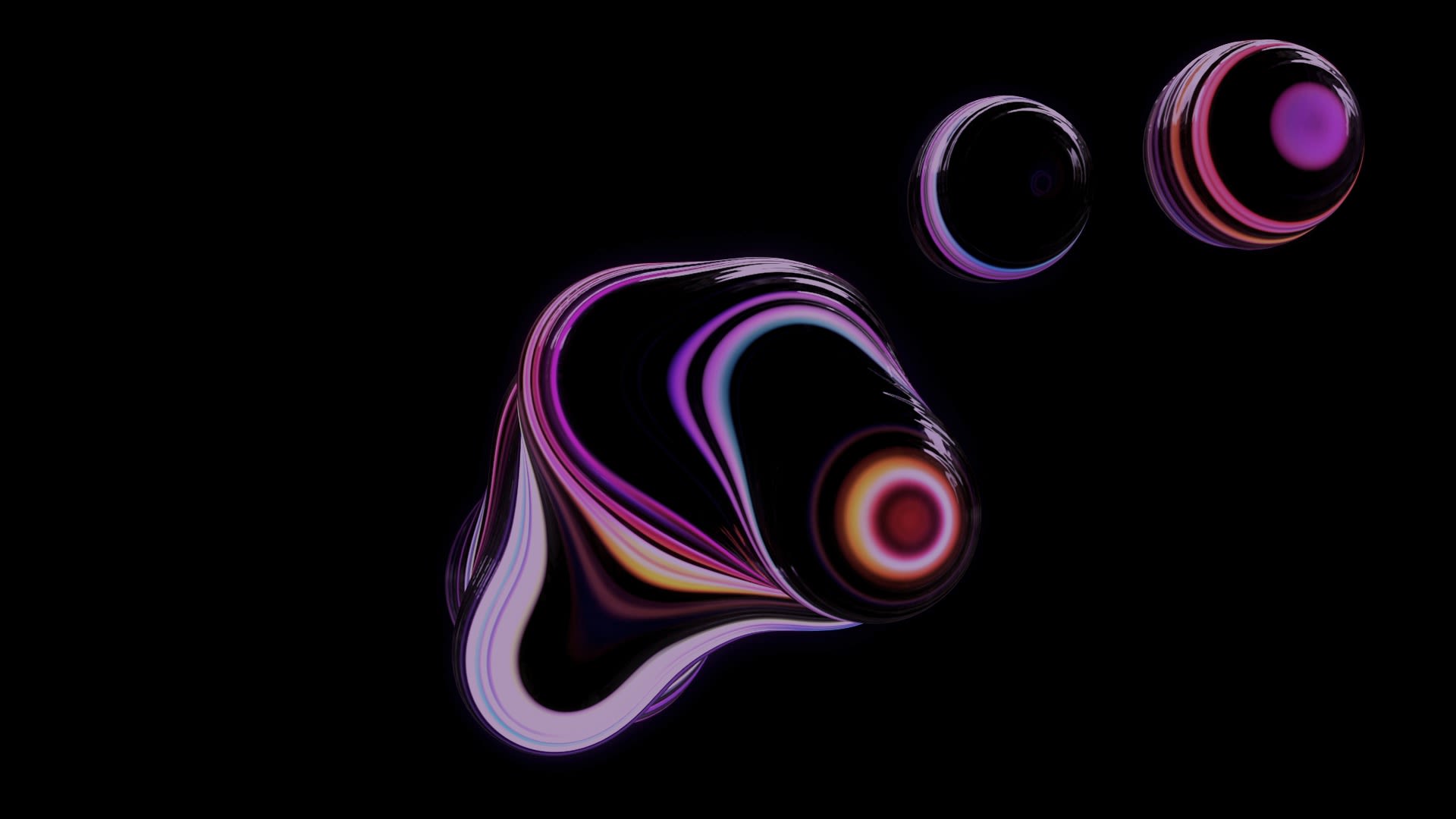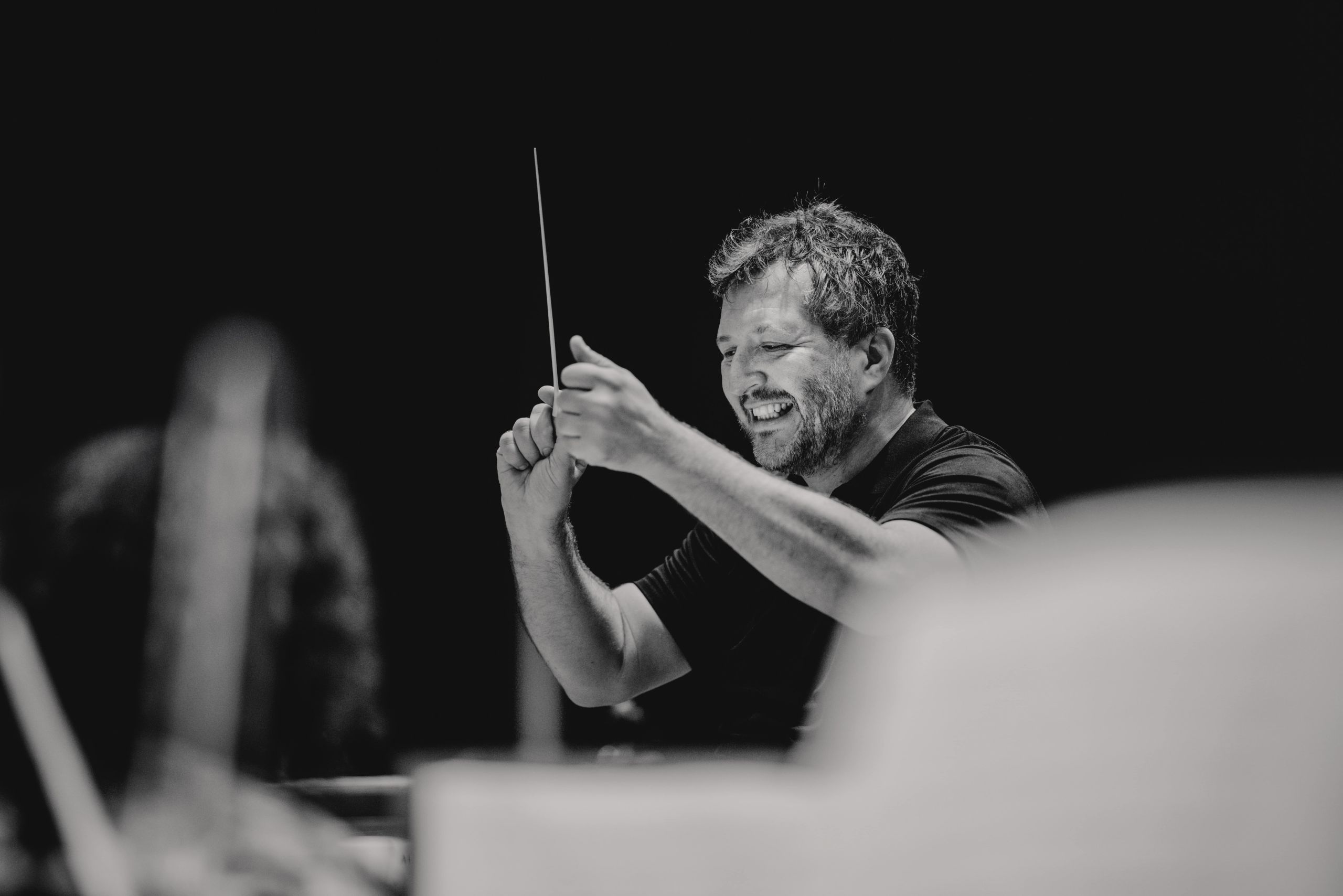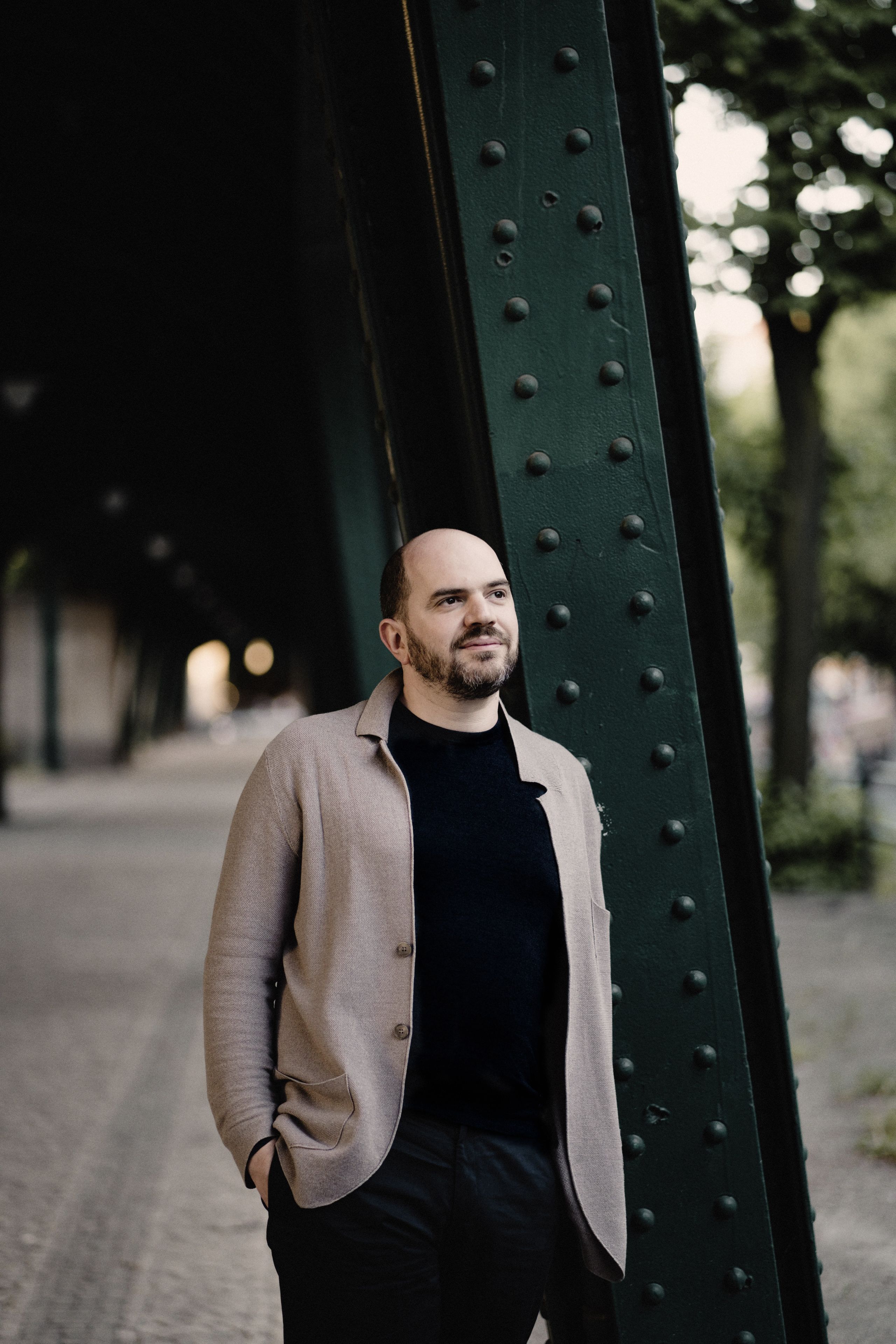London Symphony Orchestra Spring 2021
Thomas Adès 50th Birthday Concert

Recorded in the week that he turned 50, Thomas Adès conducts his piano concerto In Seven Days – a dazzling, multi-layered celebration of the act of creation – with Kirill Gerstein as soloist. And alongside Adès’ own vision of creation, he conducts Sibelius’ Sixth Symphony, throwing a fascinating new light on a living genius and his own continuing journey.
Sunday 28 March 2021
Thomas Adès 50th Birthday Concert
Sibelius Symphony No 6
Adès In Seven Days for piano and orchestra
Thomas Adès conductor
Kirill Gerstein piano
London Symphony Orchestra
This performance is broadcast on YouTube. Available to watch for free for 90 days.
Recorded at LSO St Luke's on Saturday 6 March in COVID-19 secure conditions.
Welcome and Thank You for Watching
Whilst we are unable to come together with audiences at our Barbican home, we are pleased to continue releasing a programme of online content and streamed broadcasts, making music available for everyone to enjoy digitally in the coming weeks. A warm welcome to the numerous conductors and soloists joining us, among them many firm friends and regular collaborators with the Orchestra. I am particularly delighted to welcome Thomas Adès to the podium for a celebration of his 50th birthday, conducting one of his own most masterful works, featuring soloist Kirill Gerstein, and Sibelius' Sixth Symphony.
It is a pleasure to invite you to watch and listen today online. I hope you enjoy the performance, and look forward to welcoming you back in person when we are able to re-open our doors.

Kathryn McDowell CBE DL; Managing Director
Kathryn McDowell CBE DL; Managing Director
Support the LSO's Future
The importance of music and the arts has never been more apparent than in recent months, as we’ve been inspired, comforted and entertained throughout this unprecedented period.
As we emerge from the most challenging period of a generation, please consider supporting the LSO's Always Playing Appeal to sustain the Orchestra, allow us to perform together again on stage and to continue sharing our music with the broadest range of people possible.
Every donation will help to support the LSO’s future.
You can also donate now via text.
Text LSOAPPEAL 5, LSOAPPEAL 10 or LSOAPPEAL 20 to 70085 to donate £5, £10 or £20.
Texts cost £5, £10 or £20 plus one standard rate message and you’ll be opting in to hear more about our work and fundraising via telephone and SMS. If you’d like to give but do not wish to receive marketing communications, text LSOAPPEALNOINFO 5, 10 or 20 to 70085. UK numbers only.
The London Symphony Orchestra is hugely grateful to all the Patrons and Friends, Corporate Partners, Trusts and Foundations, and other supporters who make its work possible.
The LSO’s return to work is supported by DnaNudge.
Generously supported by the Weston Culture Fund.
Share Your Thoughts
We always want you to have a great experience, however you watch the LSO. Please do take a few moments at the end to let us know what you thought of the streamed concert and digital programme. Just click 'Share Your Thoughts' in the navigation menu.
Jean Sibelius
Symphony No 6 in D minor Op 104
✒️1923 | ⏰29 minutes

1 Allegro molto moderato
2 Allegretto moderato
3 Poco vivace
4 Allegro molto
Sibelius’ Sixth Symphony has a strangely two-sided reputation. For many Sibelius devotees it is simply one of the most beautiful and original things he ever wrote; and yet it has never been anywhere near as popular as its magnificent neighbours, the Fifth and Seventh Symphonies. Perhaps the problem is that listeners have tended to approach it with the wrong expectations.
In fact the Sixth Symphony doesn’t really behave like any of the other symphonies. The musical landscape is unmistakably Sibelian: luminous writing for the strings, woodwind birdcalls, rock-like brass chords. But the language of heroism is absent: no epic striving, no soaring hymns of triumph, no confrontation with threatening inner forces. Despite the prevailing minor mode, and the melancholy tone of some of its ideas, the Sixth Symphony ultimately conveys a feeling of peace. True, there are no easily identifiable ‘great tunes’ – like the trombone theme in No 7, or the ‘Swan Hymn’ for horns and woodwind in the finale of No 5 – but the music seems to be almost constantly singing. There is also a unique purity about the expression, which Sibelius summed up by remarking that, while other composers offered the world rich cocktails, what he provided here was ‘the purest spring water’.
Another feature that sets the Sixth Symphony apart is its extensive use of the old church Dorian Mode: imagine a scale of D minor on the piano using only the white notes – no B-flat or C-sharp, for example. Such ‘modal’ writing is also common in Finnish folk music – as it is in many other folk cultures – and Sibelius had used folk-modal themes in his symphonies before. But here the character of the mode dominates the music.
Sibelius would no doubt have been thinking of one of his musical idols, the Renaissance church composer Palestrina, whose famous Stabat Mater makes telling use of the Dorian mode. But it appears he was also deeply impressed by some of the composers of the English Tudor period, whose use of modes sometimes results in unusually piquant harmonies. It’s fascinating to consider that the striking discord formed at the first entry of the trumpets and trombones in the first movement of this symphony could have been inspired by similar expressive clashes in the motets of William Byrd or Thomas Tomkins.
Formally too, the Sixth Symphony is unique. Sibelius once said that a great symphony should be like a river, and this particular musical river follows its own course throughout. The spacious, ethereal polyphony (meaning two or more simultaneous melodic lines) of the opening builds eventually to a brass-enhanced climactic discord. This is an important turning point: as the brass chord dies away, woodwind with rustling strings and harp usher in a new, more active kind of music. Eventually this develops into a sustained instrumental song, pressing forwards above busily repetitive string figures. But the end is mysterious – and strangely inconclusive.
The second movement also begins mysteriously, with a kind of slow waltz emerging gradually from quiet, plaintive woodwind chords. But this dance-like movement is suddenly cut off, and we are transported to a hushed Nordic forest landscape, with whispering strings and snatches of birdsong on woodwind. At the end the waltz is fleetingly recalled, and then the movement is over.
The third movement starts like a fairly conventional scherzo – though once again, don’t expect it to proceed on conventional lines. Before long the dotted rhythm of the opening seems to get stuck in a groove, while flutes and harp pick out a folk-like tune in imitation. The whole process is repeated, then with a sudden dramatic gesture Sibelius brings the music to an abrupt close. More folk-like phrases set the finale in motion, with groups of wind and strings alternating like two separate choirs.
Eventually the music becomes stormy (in Sibelius’ sketches, one of these turbulent ideas is labelled ‘the pine tree spirit and the wind’), but calm slowly returns after a brief reminiscence of the symphony’s opening on violins. Finally, Sibelius introduces a rapt, hymn-like coda, this time led by a choir of strings with woodwind responses. At the end, only violins, violas and hushed timpani are left, bringing the symphony to a peaceful close in the minor key.
Note by Stephen Johnson
Jean Sibelius
1865–1957 (Finland)

The portraits, the photographs and above all the music tell one story, the biographies another. From the look of the man you would probably imagine Sibelius as an austere Nordic Titan: a man with his roots deep in wild, extreme Nordic nature, one who has learned self-mastery the hard way – like the musician-wizard hero Väinänmöinen of Finnish mythology. The music – especially the later symphonies and tone poems – appears to back this up. Elementally stirring, saturated in vivid, haunting atmospheres, it is nevertheless majestically structured, shaped like the forging of steel and almost ruthlessly concentrated.
So encountering Sibelius the man, through the accounts of family, friends and colleagues, can be quite a shock. As a boy he was a strange mixture of aloofness and desperate neediness. Although he was strongly encouraged as a violinist at Helsinki University (one teacher called him a ‘genius’), Sibelius was so crippled with nerves that he eventually had to give up any thought of a career as a concert soloist – to his intense and lasting regret.
As a composer Sibelius was tormented by self-doubt, which only got worse with time and experience. Without the support and encouragement of devoted and discerning friends like Alex Carpelan he may have destroyed far more of his work than he actually did. He became an obsessive reviser: the Fifth Symphony went through two major revisions before it reached the form we know today. Eventually the only way of silencing the savage critical voice in his own head was to drown it in alcohol. Stories of Sibelius’ drinking are striking. It is said that he sketched out the slow movement of his Violin Concerto during a colossal three-day hangover. Sometimes he would just disappear, to the mortification of his wife Aino, who on more than one occasion had to drag him out of some Helsinki watering hole and prop him back up at his writing desk.
This may have been at the root of the crisis which resulted in Sibelius' famous creative silence after 1926 – despite his having another three decades to live. (He almost certainly finished, then destroyed, an Eighth Symphony some time in the early 1930s.) Aino Sibelius was a heroically patient woman, but on coming down one morning and finding Sibelius comatose at his desk yet again she finally snapped and presented the composer with an ultimatum: essentially ‘pull yourself together or I go.’ Sibelius tried to rein in his drinking, but artistically the result was that very little got past the inner censor. In the end he resigned himself to silence, and according to his daughters this brought him a kind of peace – or at least relief. Certainly he seems to have been much happier in his final years.
So why does the music give such a radically different impression? We can hear evidence of Sibelius’ agonising personal struggles in works like the Fourth Symphony and the tone poem Pohjola’s Daughter. But in the end Sibelius could be said to exemplify a principle spelled out by the poet W B Yeats: ‘The intellect of man is forced to choose: perfection of the life or of the work’. As his diaries confirm movingly, Sibelius found in music the means to confront and even transcend his own pain, fear and need. And as many have found since, the music that resulted from those struggles can help others do the same. In his day-to-day life he may have been no Titan, but in his work he was.
Composer profile by Stephen Johnson
Thomas Adès
In Seven Days for piano and orchestra
✒️2008 | ⏰30 minutes
Kirill Gerstein piano

1 Chaos – Light – Darkness –
2 Separation of the Waters into Sea and Sky – Reflection dance –
3 Land – Grass – Trees –
4 Stars – Sun – Moon
–
5 Creatures of the Sea and Sky –
6 Creatures of the Land –
7 Contemplation
In its original form, In Seven Days was a collaboration, not only between piano and orchestra, but also between music and video art, the latter created by Tal Rosner. The music beautifully adapts to its ally – and at the same time discovers rich possibilities for itself – in how it proceeds in segments, suggesting scans of a visual field, that build a continuity. Such a form allows the composer to treat the subject of Creation by focusing on creation – on how tiny particles of sound can combine, and recombine, and jostle against one another, to produce a half-hour span.
In Seven Days is a fractal composition, a work in which certain simple elements – as simple as the rising scale step that kicks the whole thing off – are repeated again and again in contexts that are in a constant state of change. This takes place thanks to the composer’s virtuoso control of rhythm and, especially, harmony, his twisted tonality emerging, totally fresh, from decades of popular music as well as from the classical tradition.
Composing against a visual counterpoint, Adès does not attempt to evoke the objects of Creation so much as the processes, and the energies. Often the result of a creative act is not one thing but two.
On the first day, for instance, God creates heaven and earth, and light and darkness. Accordingly, Adès works with musical oppositions – of orchestra and piano, of course, but also of different groups within the orchestra, or of extremities of pitch, or rival harmonic forces. His music for this first day is led off as a perpetuum mobile by the strings, whose larger cycles bring in other orchestral families. These, having been installed, set out on their own courses, the woodwinds spiralling down, the brass moving towards a chorale that heralds the piano.
Racing at double speed, the soloist soon moves into a melodious complexity that engages the orchestra and winds down into the bass, from which a rise leads into the second day. Tuned percussion enter here, in what develops from note repetitions into an infinite simultaneity of ascending and descending lines, perhaps suggesting Escher’s perpetual staircases.
The plant life of the third day burgeons as growing variation (but then, everything here is growing variation), from the extreme bass to a majestic climax.
Divine astronomy in the fourth day is figured as glittering starscapes and the beneficent harmony, perhaps, of the sun.
Days five (aquatic life) and six (terrestrial) are represented by a fugue in two sections – one without the piano, the other with the piano to the fore – telling us that everything is gentle, calming benediction. But then, at the end of the following contemplation, the whole process seems about to start over again. Creation is neverending.
Note by Paul Griffiths
Artist Biographies

Thomas Adès CBE
conductor & composer
Thomas Adès was born in London in 1971. Renowned as both composer and performer, he works regularly with the world’s leading orchestras, opera companies and festivals. His compositions include three operas: The Exterminating Angel, which was premiered at the 2016 Salzburg Festival and subsequently has been performed at the Metropolitan Opera, New York and the Royal Opera House, London, all conducted by the composer; The Tempest (Royal Opera House and Metropolitan Opera); and Powder Her Face.
His orchestral works include Asyla (premiered by the City of Birmingham Symphony Orchestra, 1997), Tevot (Berlin Philharmonic and Carnegie Hall, 2007), Polaris (New World Symphony, Miami, 2011), Violin Concerto Concentric Paths (Berliner Festspiele and the BBC Proms, 2005), In Seven Days (LA Philharmonic and Royal Festival Hall, London, 2008), Totentanz for mezzo-soprano, baritone and orchestra (BBC Proms, 2013), and Concerto for Piano and Orchestra (Boston Symphony Orchestra, 2019). His compositions also include numerous celebrated chamber and solo works.
As a conductor, he appears regularly with the Los Angeles Philharmonic, San Francisco Symphony, Boston Symphony, London Symphony, BBC Symphony, Finnish Radio Symphony, City of Birmingham Symphony Orchestras, and the Royal Concertgebouworkest, Leipzig Gewandhaus and the Orchestra of Santa Cecilia.
In opera, in addition to The Exterminating Angel, he has conducted Stravinsky's The Rake’s Progress at the Royal Opera House and the Zürich Opera, The Tempest at the Metropolitan Opera and Vienna State Opera, and Gerald Barry’s latest opera Alice’s Adventures Under Ground in Los Angeles (world premiere) and in London (European premiere).
His piano engagements have included solo recitals at Carnegie Hall (Stern Auditorium), New York and Wigmore Hall in London, and concerto appearances with the New York Philharmonic and Boston Symphony Orchestra. This season he premieres his new work for violin and piano in a recital with Leila Josefowicz at the Fondation Louis Vuitton in Paris.
His many awards include the Grawemeyer Award for Asyla (1999); Royal Philharmonic Society large-scale composition awards for Asyla, The Tempest and Tevot; Ernst von Siemens Composers' prize for Arcadiana; British Composer Award for The Four Quarters; and the prestigious Léonie Sonning Music Prize in 2015.
Kirill Gerstein
piano
Kirill Gerstein’s curiosity and versatility has led to an intense engagement with a wide range of repertoire and styles. From Bach to Adès, Gerstein's playing is distinguished by its clarity of expression, discerning intelligence and virtuosity, and an energetic, imaginative musical presence.
Based in Berlin, Kirill Gerstein appears worldwide in performances ranging from concerts with the Chicago and Boston Orchestras, the Leipzig Gewandhaus, Royal Concertgebouw, Vienna and Berlin Philharmonics, London Symphony Orchestra and the Bavarian Radio Symphony Orchestra, to recitals in London, Berlin, Vienna, Paris and New York.
A long-time believer in the role of teaching, Kirill Gerstein is Professor of Piano at Berlin’s Hanns Eisler Hochschule under whose auspices he recently launched a series of free and open online seminars entitled Kirill Gerstein Invites, featuring conversations with leading musicians, musicologists and philosophers.
Over the last year, Gerstein’s decade-long relationship with Thomas Adès came to the fore with the world and European premieres of Adès’ Concerto for Piano and Orchestra, written especially for Gerstein. Deutsche Grammophon’s world premiere live recording release of the new work – winner of the Contemporary category at the 2020 Gramophone Awards – captured in Boston was followed shortly by Gerstein’s own release on myrios classics of Adès' compositions.
Born in 1979 in Voronezh, Russia, Kirill Gerstein attended one of the country’s special music schools for gifted children and taught himself to play jazz by listening to his parents’ record collection. Following a chance encounter with jazz legend Gary Burton in St Petersburg when he was 14, he was invited to attend the Berklee College of Music in Boston, where he studied jazz piano in tandem with his classical piano studies. At the age of 16 he decided to focus on classical music, continuing his studies with Solomon Mikowsky in New York, Dmitri Bashkirov in Madrid and Ferenc Rados in Budapest.
Gerstein is the sixth recipient of the prestigious Gilmore Artist Award, First Prize winner at the Tenth Arthur Rubinstein Competition and an Avery Fisher Career Grant holder.
London Symphony Orchestra
The London Symphony Orchestra was established in 1904, and is built on the belief that extraordinary music should be available to everyone, everywhere.
Through inspiring music, educational programmes and technological innovations, the LSO’s reach extends far beyond the concert hall.
Visit our website to find out more.

On Stage
Leader
Carmine Lauri
First Violins
Clare Duckworth
Maxine Kwok
William Melvin
Claire Parfitt
Laurent Quenelle
Harriet Rayfield
Sylvain Vasseur
Second Violins
Julian Gil Rodriguez
Sarah Quinn
Miya Väisänen
David Ballesteros
Matthew Gardner
Naoko Keatley
Andrew Pollock
Paul Robson
Violas
Edward Vanderspar
Malcolm Johnston
Anna Bastow
German Clavijo
Sofia Silva Sousa
Cellos
Rebecca Gilliver
Alastair Blayden
Daniel Gardner
Laure Le Dantec
Amanda Truelove
Double Basses
Colin Paris
Patrick Laurence
Matthew Gibson
Joe Melvin
Flutes
Gareth Davies
Rebecca Larsen
Piccolos
Sharon Williams
Oboes
Juliana Koch
Rosie Jenkins
Maxwell Spiers
Clarinets
Chris Richards
Chi-Yu Mo
Katy Ayling
Bass Clarinet
Katy Ayling
Bassoons
Rachel Gough
Dominic Tyler
Contra Bassoon
Martin Field
Horns
Alexander Edmundson
Jonathan Durrant
James Pillai
Jonathan Maloney
Paul Gardham
Trumpets
Jason Evans
Aaron Akugbo
Niall Keatley
Toby Street
Trombones
Peter Moore
Andrew Cole
Bass Trombones
Paul Milner
Tuba
Ben Thomson
Timpani
Nigel Thomas
Percussion
Neil Percy
David Jackson
Sam Walton
Tom Edwards
Jeremy Cornes
Paul Stoneman
Harps
Bryn Lewis
Meet the Members of the LSO on our website
Thank You for Watching







